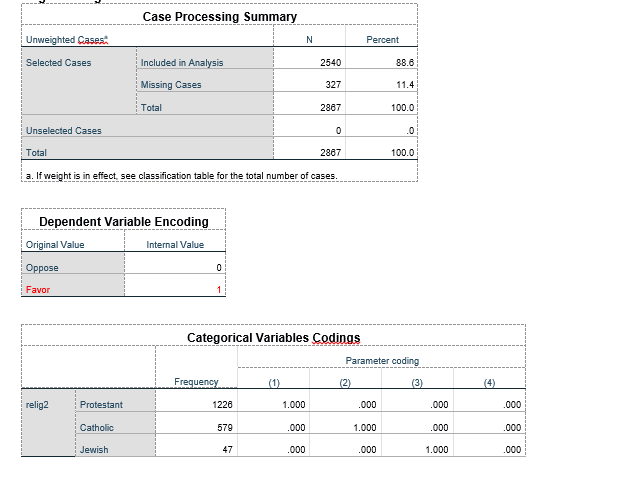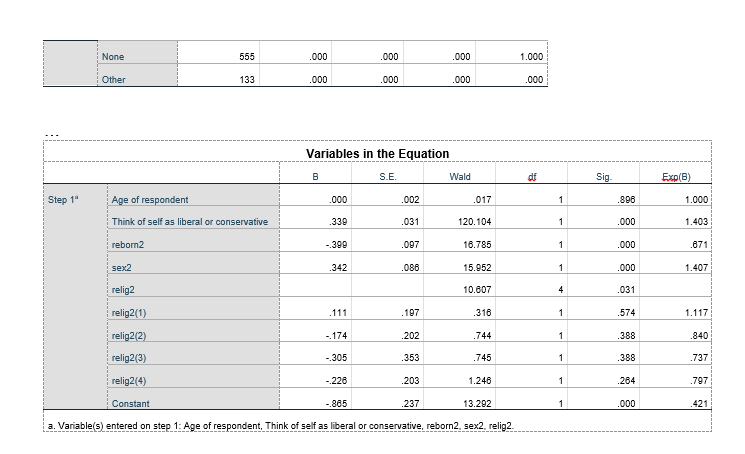Question
Questions and activities We will be looking at what factors (let's use age, polviews, reborn, sex, religion) might influence public opinion about favoring death penalty
Questions and activities
We will be looking at what factors (let's use age, polviews, reborn, sex, religion) might influence public opinion about favoring death penalty for murder (cappun).
1. Draw a model of this regression analysis using boxes and arrows diagram.
a. HINT: You need to make clear which are the independent and dependent variables, and what the direction of influence is.
2. Replicate the SPSS output provided below.
a. Run Logistic regression (Analyze>Regression>Binary Logistic) using the following variables from the GSS 2016: cappun, age, polviews, reborn, sex, religion. The interface is very similar to the linear regression one, but with "covariates" instead of "independent variables".
b. HINT: Before running the logistic regression, you will need to recode the following variables (best to use "Transform>Recode into different variables" so you don't lose the original data):
i. Dependent Variable (cappun) so that 1 = Favor and 0 = Oppose. E.g. new variable called cappun2. The "Old-->New" box should look like this: 2-->0; 1-->copy; ELSE-->SYSMIS. After creating new variable, make sure to create new "values" on Variable View, e.g. 0 = "Oppose", 1 = "Favor".
ii. Independent Variables: Recode "Reborn" variable so that 1 = Reborn experience and 0 = No reborn experience (rest system missing). Make sure to label new variable values!
iii. Recode "Sex" variable so that 1 = Male and 0 = Female (rest system missing). Label new variable values!
iv. Do two things with the Religion variable: a) recode to move any religions not in the results below to "other"; b) identify this recoded variable as categorical when running the logistic regression. Label new variable values!
3. Provide the full logistic regression analysis of the SPSS output. Specifically, look at the "Variables in the Equation" table and interpret the EXP (B) coefficient (odds) for the significant results. NOTE: The coding for the variable is presented in the SPSS Variable View in the "Values" column. Click on any variable you need information about. The variables' coding will help you to interpret the odds correctly.
a. HINT: Put another way: Are Conservatives more likely to favor the death penalty? Are Men more likely to favor the death penalty? The Exp(B) for polviews and sex tell you whether they are more likely (>1) or less likely (
4. Calculate the probability of favoring death penalty for murder for a catholic man, moderate in political views and without "born again" experience. HINT: Examples calculations used for this and Q5 are provided below. There are also examples in the slides and videos; however these are for older GSS data, and so have different results.
5. Calculate the probability of favoring death penalty for murder for a non-believer woman with a "born again" experience and extremely liberal in her political views.
REPLICATE THE FOLLOWING FOR QUESTION 2! THEN YOU CAN USE THE RESULTS FOR QUESTIONS 3-5
NOTE: ONLY KEY RESULTS ARE INCLUDED
Logistic Regression


Further Instructions:
The odds ratios can be obtained directly from the SPSS output. You can run in SPSS by selecting Analyze/Regression/Binary Logistic
As for the results interpretation, the odds ratios (Exp(B)) are a way to indicate the influence of the independent variable upon the dependent variable. For example, if you have had a Reborn experience, you are 2:1 likely to favor the death penalty.
Hopefully these links are helpful in general regarding SPSS logistic regression (https://stats.idre.ucla.edu/spss/output/logistic-regression/) and specifically to odds ratios (https://stats.idre.ucla.edu/other/mult-pkg/faq/general/faq-how-do-i-interpret-odds-ratios-in-logistic-regression/)
Calculating probabilities
Note the following steps to convert the log odds to probabilities:
log odds = constant + (B1)(age) + (B2)(polviews) + (B3)(reborn) + (B4)(sex) + (B5)(religion1) + (B6)(religion2) + (B7)(religion3) + (B8)(religion4)
[Note here that you need to establish first what the variable values are. For the dummies, it is usually yes = 1, no = 0, regardless of the initial coding (if in doubt, make sure to recode the variables so they make sense). This way you can also check that the sign of the resulting coefficients follows intuition - e.g. that political views (ranges from extremely liberal = 1...to...extremely conservative = 7) and likelihood of favoring capital punishment (0 = oppose, 1 = favor) are positively correlated].
log odds = Z
odds = exp(Z)
prob = exp(Z) / (1+exp(Z) )
Example: Probability of extremely conservative male (no religion) favoring the death penalty:
log odds = constant + (B1)(age = 0) + (B2)(polviews = 7) + (B3)(reborn = 0) + (B4)(sex = 1) + (B5)(religion1=0) + (B6)(religion2=0) + (B7)(religion3=0) + (B8)(religion4=1)
log odds = -0.865 + (7*0.339) +0.342 - 0.226 = -0.865 + 1.356 + 0.342 - 0.226 = 1.624
odds = exp(1.624) = 5.073
prob = 5.073/(1+5.073) = 83.5%
In written terms: the average person (constant term) is reducing the likelihood of favoring the death penalty, but this is more than offset by the conservative political views, which increases the likelihood significantly.
Here is a brief discussion of how to obtain probabilities from odds ratios: http://www.pmean.com/13/predicted.html
And here is a more in-depth discussion of logistic regression in general: http://www.restore.ac.uk/srme/www/fac/soc/wie/research-new/srme/modules/mod4/module_4_-_logistic_regression.pdf
Case Processing Summary Unweighted Cases N Percent Selected Cases 2540 88.8 Included in Analysis Missing Cases 327 11.4 Total 2887 100.0 Unselected Cases 0 .0 Total 2887 100.0 a. If weight is in effect, see classification table for the total number of cases. Dependent Variable Encoding Original Value Internal Value Oppose 0 Favor 1 Categorical Variables Codings Parameter coding Frequency (0) (2) (3) (4) relig2 Protestant 1220 1.000 .000 .000 .000 Catholic 579 .000 1.000 000 .000 Jewish 47 .000 .000 1.000 .000 None 555 .000 .000 .000 1.000 Other 133 .000 .000 .000 .000 Variables in the Equation B S.E. Wald df Sig Exp(B) Step 1" Age of respondent .000 .002 .017 1 .898 1.000 Think of self as liberal or conservative 339 .031 120.104 1 .000 1.403 reborn2 - 399 .097 16.785 1 .000 .871 sex2 342 .088 15.952 1 .000 1.407 relig2 10.607 4 .031 relig2(1) .111 .197 .318 1 .574 1.117 relig2(2) - 174 .202 .744 1 .388 .840 relig2(3) - 305 .353 .745 1 .388 .737 relig2(4) - 228 .203 1.248 1 .264 .797 Constant -.865 .237 13.292 1 .000 .421 Variable(s) entered on step 1: Age of respondent, Think of self as liberal or conservative, reborn2. sex2, relig2. Case Processing Summary Unweighted Cases N Percent Selected Cases 2540 88.8 Included in Analysis Missing Cases 327 11.4 Total 2887 100.0 Unselected Cases 0 .0 Total 2887 100.0 a. If weight is in effect, see classification table for the total number of cases. Dependent Variable Encoding Original Value Internal Value Oppose 0 Favor 1 Categorical Variables Codings Parameter coding Frequency (0) (2) (3) (4) relig2 Protestant 1220 1.000 .000 .000 .000 Catholic 579 .000 1.000 000 .000 Jewish 47 .000 .000 1.000 .000 None 555 .000 .000 .000 1.000 Other 133 .000 .000 .000 .000 Variables in the Equation B S.E. Wald df Sig Exp(B) Step 1" Age of respondent .000 .002 .017 1 .898 1.000 Think of self as liberal or conservative 339 .031 120.104 1 .000 1.403 reborn2 - 399 .097 16.785 1 .000 .871 sex2 342 .088 15.952 1 .000 1.407 relig2 10.607 4 .031 relig2(1) .111 .197 .318 1 .574 1.117 relig2(2) - 174 .202 .744 1 .388 .840 relig2(3) - 305 .353 .745 1 .388 .737 relig2(4) - 228 .203 1.248 1 .264 .797 Constant -.865 .237 13.292 1 .000 .421 Variable(s) entered on step 1: Age of respondent, Think of self as liberal or conservative, reborn2. sex2, relig2Step by Step Solution
There are 3 Steps involved in it
Step: 1

Get Instant Access to Expert-Tailored Solutions
See step-by-step solutions with expert insights and AI powered tools for academic success
Step: 2

Step: 3

Ace Your Homework with AI
Get the answers you need in no time with our AI-driven, step-by-step assistance
Get Started


